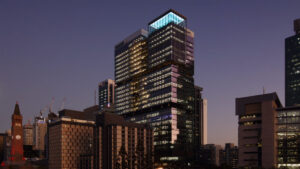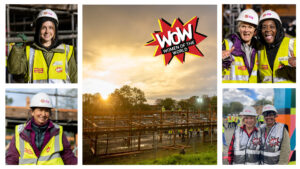ARTICLE
The art of gathering
12:10:56 4 April 2024
51.6762° N, 4.9184° W
Much of the following first appeared as a set of smaller articles on Linked-In. Thoughts posted there over the last month or so have been enriched by the conversation they stimulated – a big thank you for engaging so readily, and for helping an old(ish) man see that bit more clearly. Unless quoting an individual, I acknowledge everyone at the end of the piece so as to allow the piece to flow.
The tyranny of the empty space
Perhaps I’m getting over-sensitive in my old age, but I feel oppressed by what feels like the decline in the art of gathering. The tyranny of the empty space is upon us and no more so than where we might least expect it: our cities.

The reasons are no doubt myriad, with advances in technology, or the conditioning of whole lives spent indoors on screens, or the long tail of Covid, all standing in as strong candidates. However, I think it may also be a symptom of modern city making, which in post-industrial countries is relatively fast, often inorganic, and obsesses on skylines, silhouettes, and the sculptural quality of its buildings. They don’t come from or have grown through the long traditions of gathering. Any doubts about this, go visit New Songdo and look for anything resembling what might be called a bottom-up gathering.
The city is the future, for all sorts of reasons, not least economic necessity, cultural diversity, innovation and creativity, and its (presently counterintuitive) contribution to slowing environmental change. It’d be a massive shame if the Smart or U-City – for all its extraordinary technological and engineering wizardry – were to edit out what makes the city what it is: the gathering of the many, in all sorts of forms, and in all sorts of spaces.
From mixed amenity to mixed experience
As many have pointed out, not all cities and not everywhere in the city suffer this tyranny. While many a city centre’s ‘busy-ness’ has been ‘designed out’, we are all of us largely able to shine an excited light on areas in our own home cities abuzz with activity.
However, there’s no doubt that our city centres and high streets have for many years been fighting the combined effect of the car-orientated zoning, out-of-town amenities, online shopping, remote working patterns, and soaring rents. The assumption among urban planners and policy makers that we can simply build our way out of the problem has had decidedly mixed results. Infrastructure-led Capex solutions do not – in and of themselves – make for a thriving heterogenous city centre. Life does, as Jan Gehl would say.
All of which doesn’t mean the end of the capital expenditure projects, but rather that we focus on how we might spark activity and engagement through ongoing Opex interventions, catalytic programmes of activites that require – if they are to succeed – the active participation of those they seek to serve. Not to be confused with the ‘positive list’ of amenities sold in planning as a given intervention’s ‘scope list’ of benefits, these programmes of activities herald a nuanced ‘mixed experience’ approach to the (re)development of our cities.
The 21st century destination office
It’s possible that we’re in the midst of what physicists call a phase change, one that sees the city evolving beyond the worker as its ‘ideal urban actor’ – as the neuroscientist and designer Menno Cramer puts it. Nevertheless, there’s little doubt – at least to my mind – that work remains a central reason for gathering in large numbers and that any (re)development ought to focus on reinventing what it means for the city to be a place of work, a place constantly informed by and which has the capacity to flex to the experience of an end user that operates in a world of (increasing) uncertainty.

You will have your own examples of those workplaces that do exactly this. If not, I urge you to look up Australian bank Suncorp’s now much vaunted home offices Heritage Lanes, designed, developed, and partly owned by Mirvac, and which was relatively recently awarded a Leesman+ (workplace experience) certificate.* Advertised as a ‘destination office’ long before the post-Covid world began to speak of such things, it is a wonderful example of how to programme for many types of flow: the employee experience is reinforced by and constantly informs the use of its ‘superhub’ and ‘destination’ floors; the concierge service and the planting facilitate beautiful movement throughout the building; a calendar of regular and one-off events creates a genuinely festivalist feel; and the building is in permanent and generous conversation with the wider city. Far greater than the sum of its amenity parts, Heritage Lanes is so much more than an office – as anyone lucky enough to work there would no doubt attest.
If we are to confound predictions that 30% of commercial real estate in the likes of London and New York will be empty by 2030, we would do well to take note of whatever it is that Heritage Lanes and others are doing to buck the trend. It is Mirvac’s constant championing of the ‘shared value’ or ‘mixed experience’ development – wherein ‘cities as a collection of villages, precincts and buildings are activated through programming to act as a magnet for people’ – that gives purpose and value to the notion of Heritage Lanes as a highly viable version of the the 21st century destination office and more generally as a means of bringing us back together, in ways that are as commercially astute as they are socially useful.
*Full disclosure, FreeState was involved in helping create the experience framework that served and continues to serve as the ‘experience underlay’ to Heritage Lanes’s design. However, I wouldn’t want to overplay our part. Like all strategies, it will have evolved over the time, getting better and better as the research moved into design and on into build.
Going properly (co)creative
If I’m correct in my understanding of the implications of Cramer’s thoughts about a possible sea change in the identity of the ideal urban actor and in what qualities we might expect of city life as a result of the shift, then it’s vital that our cities have the capacity to adapt to and exploit that change. I would suggest that means looking back as much as it does forward, and that it begin with the notion of co-creation.
Earlier this year, I was invited– as reported elsewhere – by creative city specialist for the City of Ballarat Tara Poole to speak alongside philosopher and cultural thinker Dr. Byung Hoon Jeong and cultural and visual arts consultant and curator Jude van der Merwe at the inaugural International Craft Summit in Jajpur, India. One of the key takeaways was that the post-industrial city serves as cautionary tale for the likes of Jajpur, who’s still thriving craft ecosystem must negotiate the inevitability of modernity. It fell to me to identify – using LEEDS 2023‘s designs on creating a cultural destination city as example – where these cautionary tales are sprouting new craft-driven shoots.

One of those shoots is the now dismantled WOW Barn, which saw 300 women, girls, and non-binary people build a barn on Cinder Moor in 24 hours, and then utilise it across the next three weeks to hold gatherings where people imagined – through activities, talks, and workshops – an existance ‘in which women, girls, and non-binary people have the space, support, and permission to live their dreams in an equitable world’. There are many reasons to love the intervention, most of which I’ll leave for you to discover in your own time. Riffing on our theme, however, what I personally like about the WOW Barn is the fact that its inspiration, design, delivery, and ongoing use was born of and led by its gathering users.
In a world where the term has been so overused as to be exhausted of all meaning, the WOW Barn is a small and very wonderful example of what it takes to co-create places to gather meaningfully.
A cluster of never-final thoughts
The tyranny of the empty space is not necessarily the end of the city centre. No reign – however tyrannical – lasts forever. Whether it is via enlightened thinking around the 21st workplace or the bottom-up facilitation of the creative city or indeed anything else that genuinely involves the ‘end user’ in every aspect of the design-build-activate-manage-improve pipeline, working out ways to programme for gathering at a city-sized scale is more than desirable: it is – as theoretical physicist and fan of the city Geoffery West might say – absolutely necessary.
Award winning designer and speaker and thinker on all things city related, Adam Scott is co-founder and creative director at FreeState. Thank you to Steven Weir, Menno Cramer, Lisa Harvey, Louisa Tan, James Bowthorpe, James Wallman, Julian Rad, Kully Thiarai, and Kira Curtis for applying much grist to the conversation mill. If this article has piqued your city-developing interest, please get in touch. If we can’t help, we almost certainly know someone who can.



